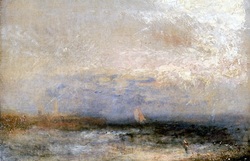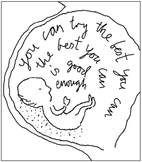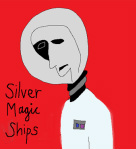
See: Evans, Gareth (2011) "Doubts held over Turner painting vanish in the mist; after 50 years art work at museum is declared genuine", The Western Mail, 01/08, p.15, accessed 01/08/2011 at, http://www.walesonline.co.uk/news/wales-news/2011/08/01/doubts-held-over-turner-painting-vanish-in-the-mist-91466-29154179/ (text available here)
The reporting of this story is worth considering in detail.
We are told at the outset that the painting entitled Off Margate was purchased by the museum in 1908. However, later on, Beth McIntyre (a curator at the museum) is cited as saying that the "painting was part of a large bequest to the museum in 1951 and shortly after it arrived, an expert questioned its authenticity. In those days, working out authorship wasn't a question of science as it can be today, it was a question of 'this doesn't quite feel right'."
However, unnamed "experts" working at Tate in London have now declared that Off Margate is "entirely characteristic" of the work of J.M.W. Turner (1775-1851). Yet we are not told how they reached this decision: was it "a question of science" or just their "expert" eyes that determined if it was authentic or not? It seems that artistic style played a key role in questioning the painting's authenticity in the first place. McIntyre remarks that, "while it was identified as a Turner, the 'late' style was questioned at the time.” This was despite the fact that the "painting had good historic provenance" meaning that McIntyre and her colleagues "could trace its ownership back a long way". To what extent did this supporting evidence influence those unnamed "experts" at Tate?
Interestingly, the Western Mail journalist who wrote this newspaper article chose to add the following statement:
"Turner remains one of Britain’s most celebrated artists. His work is instantly recognisable
and remains, some 160 years after his death, among the most sought-after in the world."
If his work is "instantly recognisable", why was it so difficult to decide if Turner painted Off Margate?
We are told that it was McIntyre who thought of asking "Tate experts" to examine the work. This, adds the journalist, was a "decision [that] paid off." But in the article this "payment" is expressed solely in terms of financial rather than artistic value:
"The precise value of Off Margate is unclear, but a painting by Turner depicting a
Welsh castle drenched in the orange glow of a sunrise last year fetched more
than £500,000 at auction. The watercolour sketch over pencil of Flint Castle,
which dates from the early 1830s, sold to a private collector at Sotheby's for £541,250.
A piece by another English artist depicting what some regard as a quintessentially
English view of Wales – William Dyce's Welsh Landscape with Two
Women Knitting – sold for more than £500,000 in 2009."
Whilst we are informed about the potential auction price for Off Margate, we are not told how much the museum paid for it (assuming that it did indeed purchase the painting in 1908).
The Western Mail's framing of the story, with its inclusions, exclusions and points of emphasis really matters given that recent changes to the UK's Code of Ethics "now allows financially motivated disposal... in exceptional circumstances" (section 6.14).
The story of Off Margate touches on important museological issues regarding the use and interpretation of objects; the role of "experts" and of how decisions are reached when it comes to authenticity. This leads to additional questions: Were doubts about the painting conveyed to the public from the 1950s until today or did it hang in the gallery without comment? Or was it locked away in the museum store? What additional "fakes" might be similarly forgotten about in the "worthless" reserve collection? Does the museum own other artworks of debatable authenticity? Are there examples of works that the museum considered to be genuine but have later been labelled "fake"? Do experts always agree and, if not, how do we decide who to believe? What impact do technological developments have on opinion-making? And what role do personal contacts play in getting the support of "experts"?
Instead, by focusing just on money, the Western Mail newspaper encourages this sort of comment:
Who cares: it's either art or not.
Oh! sorry it's either money or not.
siarad 9:27 AM on August 1, 2011
This was the only reader's comment that followed the article at the time I accessed it. But "siarad" shouldn't be blamed for reducing the Museum of Wales's art to a question of money. The fault lies with the way the Western Mail newspaper has framed the story. It encourages its readers to look upon the National Museum of Wales as primarily a place of financial rather than cultural capital.






